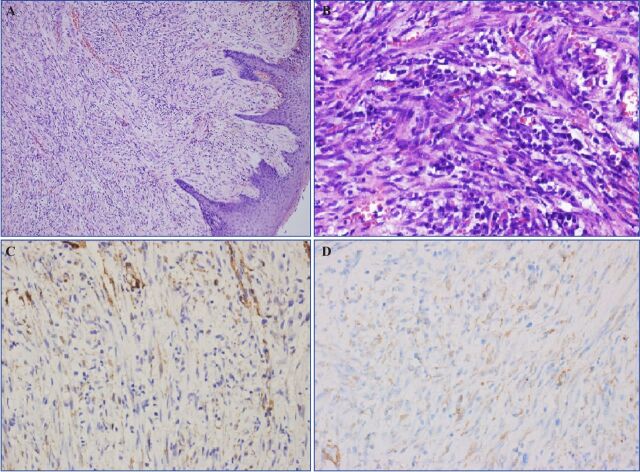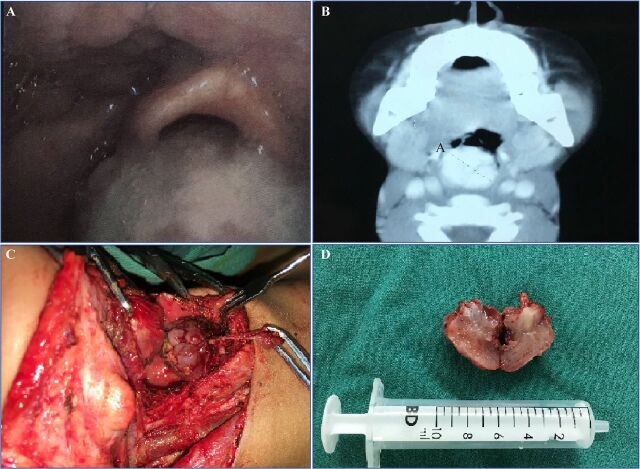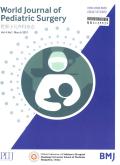{"title":"下咽巨大炎性肌纤维母细胞瘤:6岁儿童急性上呼吸道阻塞的罕见病因。","authors":"Liu Yang, Wen Li","doi":"10.1136/wjps-2021-000342","DOIUrl":null,"url":null,"abstract":"© Author(s) (or their employer(s)) 2022. Reuse permitted under CC BYNC. No commercial reuse. See rights and permissions. Published by BMJ. INTRODUCTION Acute upper airway obstruction (UAO) in children is a common disease in the emergency department. It is lifethreatening and usually caused by laryngospasm or laryngeal edema owing to infection, allergy, or a foreign body. In addition, pediatric UAO can also be the result of laryngopharyngeal spaceoccupying lesions, such as laryngeal papilloma, lymphangioma, hemangioma, or cyst. Malignancy is uncommon. Inflammatory myofibroblastic tumor (IMT) is a mesenchymal tumor consisting of differentiated spindle fibroblast cells with plasma cells and/or lymphocytes infiltration. The most common sites of IMT are the lungs, gastrointestinal tract, urogenital tract, abdominal cavity, viscera, central nervous system, upper respiratory tract, and soft tissue. IMT in the head and neck region accounts for only 14%–18% of extrapulmonary lesions, of which the orbit and nasal sinus are common locations. According to the reported cases of laryngeal IMT (fewer than 50 cases), it is usually confined to the glottic region. A lesion with supraglottic and hypopharyngeal involvement is extremely rare and only five cases have been reported in the hypopharynx to date. These cases occurred in adults, including only one female patient. We describe an extremely rare case of giant IMT in the hypopharynx of a female child with respiratory distress as the initial symptom.","PeriodicalId":23823,"journal":{"name":"World Journal of Pediatric Surgery","volume":null,"pages":null},"PeriodicalIF":0.8000,"publicationDate":"2022-01-01","publicationTypes":"Journal Article","fieldsOfStudy":null,"isOpenAccess":false,"openAccessPdf":"https://ftp.ncbi.nlm.nih.gov/pub/pmc/oa_pdf/fc/15/wjps-2021-000342.PMC9648570.pdf","citationCount":"0","resultStr":"{\"title\":\"Giant inflammatory myofibroblastic tumor of the hypopharynx: an unusual cause of acute upper airway obstruction in a 6-year-old child.\",\"authors\":\"Liu Yang, Wen Li\",\"doi\":\"10.1136/wjps-2021-000342\",\"DOIUrl\":null,\"url\":null,\"abstract\":\"© Author(s) (or their employer(s)) 2022. Reuse permitted under CC BYNC. No commercial reuse. See rights and permissions. Published by BMJ. INTRODUCTION Acute upper airway obstruction (UAO) in children is a common disease in the emergency department. It is lifethreatening and usually caused by laryngospasm or laryngeal edema owing to infection, allergy, or a foreign body. In addition, pediatric UAO can also be the result of laryngopharyngeal spaceoccupying lesions, such as laryngeal papilloma, lymphangioma, hemangioma, or cyst. Malignancy is uncommon. Inflammatory myofibroblastic tumor (IMT) is a mesenchymal tumor consisting of differentiated spindle fibroblast cells with plasma cells and/or lymphocytes infiltration. The most common sites of IMT are the lungs, gastrointestinal tract, urogenital tract, abdominal cavity, viscera, central nervous system, upper respiratory tract, and soft tissue. IMT in the head and neck region accounts for only 14%–18% of extrapulmonary lesions, of which the orbit and nasal sinus are common locations. According to the reported cases of laryngeal IMT (fewer than 50 cases), it is usually confined to the glottic region. A lesion with supraglottic and hypopharyngeal involvement is extremely rare and only five cases have been reported in the hypopharynx to date. These cases occurred in adults, including only one female patient. We describe an extremely rare case of giant IMT in the hypopharynx of a female child with respiratory distress as the initial symptom.\",\"PeriodicalId\":23823,\"journal\":{\"name\":\"World Journal of Pediatric Surgery\",\"volume\":null,\"pages\":null},\"PeriodicalIF\":0.8000,\"publicationDate\":\"2022-01-01\",\"publicationTypes\":\"Journal Article\",\"fieldsOfStudy\":null,\"isOpenAccess\":false,\"openAccessPdf\":\"https://ftp.ncbi.nlm.nih.gov/pub/pmc/oa_pdf/fc/15/wjps-2021-000342.PMC9648570.pdf\",\"citationCount\":\"0\",\"resultStr\":null,\"platform\":\"Semanticscholar\",\"paperid\":null,\"PeriodicalName\":\"World Journal of Pediatric Surgery\",\"FirstCategoryId\":\"3\",\"ListUrlMain\":\"https://doi.org/10.1136/wjps-2021-000342\",\"RegionNum\":4,\"RegionCategory\":\"医学\",\"ArticlePicture\":[],\"TitleCN\":null,\"AbstractTextCN\":null,\"PMCID\":null,\"EPubDate\":\"\",\"PubModel\":\"\",\"JCR\":\"Q4\",\"JCRName\":\"PEDIATRICS\",\"Score\":null,\"Total\":0}","platform":"Semanticscholar","paperid":null,"PeriodicalName":"World Journal of Pediatric Surgery","FirstCategoryId":"3","ListUrlMain":"https://doi.org/10.1136/wjps-2021-000342","RegionNum":4,"RegionCategory":"医学","ArticlePicture":[],"TitleCN":null,"AbstractTextCN":null,"PMCID":null,"EPubDate":"","PubModel":"","JCR":"Q4","JCRName":"PEDIATRICS","Score":null,"Total":0}
引用次数: 0
Giant inflammatory myofibroblastic tumor of the hypopharynx: an unusual cause of acute upper airway obstruction in a 6-year-old child.
© Author(s) (or their employer(s)) 2022. Reuse permitted under CC BYNC. No commercial reuse. See rights and permissions. Published by BMJ. INTRODUCTION Acute upper airway obstruction (UAO) in children is a common disease in the emergency department. It is lifethreatening and usually caused by laryngospasm or laryngeal edema owing to infection, allergy, or a foreign body. In addition, pediatric UAO can also be the result of laryngopharyngeal spaceoccupying lesions, such as laryngeal papilloma, lymphangioma, hemangioma, or cyst. Malignancy is uncommon. Inflammatory myofibroblastic tumor (IMT) is a mesenchymal tumor consisting of differentiated spindle fibroblast cells with plasma cells and/or lymphocytes infiltration. The most common sites of IMT are the lungs, gastrointestinal tract, urogenital tract, abdominal cavity, viscera, central nervous system, upper respiratory tract, and soft tissue. IMT in the head and neck region accounts for only 14%–18% of extrapulmonary lesions, of which the orbit and nasal sinus are common locations. According to the reported cases of laryngeal IMT (fewer than 50 cases), it is usually confined to the glottic region. A lesion with supraglottic and hypopharyngeal involvement is extremely rare and only five cases have been reported in the hypopharynx to date. These cases occurred in adults, including only one female patient. We describe an extremely rare case of giant IMT in the hypopharynx of a female child with respiratory distress as the initial symptom.



 求助内容:
求助内容: 应助结果提醒方式:
应助结果提醒方式:


